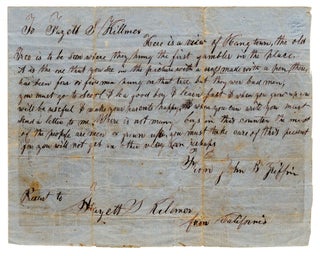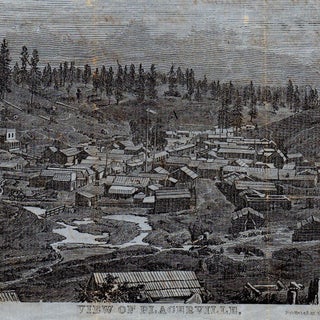View of Placerville.
[Placerville? or San Francisco?]: Published at the Union Office, [circa 1851]. Wood engraving, 5.25” x 7.5”, on a sheet of blue laid paper, 6.25” x 7.875”; manuscript note in ink on verso. An apparently unrecorded California pictorial lettersheet illustrated with a view of the mining town of Placerville, with an appealing presentation note on the verso addressed to a boy. Depicting more or less the entirety of this important gold rush town from an elevated vantage point, and feeling very much as if it’s based on a daguerreotype, this previously unrecorded view differs significantly from the two views of Placerville recorded by Baird, representing more of the town than one of them and depicting it with greater specificity than the other. It shows a concentration of buildings nestled into a valley, more or less arranged along the axis of Main Street, along which a few figures can be seen strolling. On a road at the lower left a stagecoach arrives in town, possibly meant to represent the Pony Express, which ended in Placerville. A manuscript X appearing near the center of the image marks a hanging tree, as indicated by Griffin in his note on the verso. The note reads:
To Fayett S. Killmer[,] Here is a view of Hangtown [as it was known for a time], the old tree is to be seen where they hung the first gambler in the place. it is the one that you see in the picture with a cross made with a pen. there has been four or five men hung on that tree but they were bad men. you must go to school & be a good boy & learn fast & when you grow up you will be useful & make your parents happy. when you can write you must send a letter to me. there is not many boys in this country. the most of the people are men or grown up. you must take care of this present for you will not get an other very soon perhaps. From John B. Griffin Present to Fayett S. Killmer from California[.]
The lower half of the sheet has been removed and there are traces of ink along the lower edge, suggesting that Griffin used the lower half for a letter to another correspondent.
As observed by Erwin Gudde, Placerville “was first settled in 1848 by William Daylor of Sutter’s Fort and became known as Dry Diggings. In 1850 the camp was named Placerville because the streets of the camp were almost impassable on account of numerous placing holes. The town never bore the name Hangtown, as is often asserted by contemporary as well as modern writers. It was simply a nickname given to the place because of an incident which occurred on January 22, 1849, a Sunday, when two Frenchman and one Chileno were hanged, as witnessed by E. Gould Buffum” (Gudde, p. 250).
“An important stopping point on a major overland trail, [Placerville] enjoyed a population boom, becoming a supply center, a station on the Central Pacific Railroad, and the western end of the Pony Express” (Hart, p. 332).
Not in OCLC, Baird, Clifford Collection, or Reps. Baird records four Placerville letter sheets. The sheet offered here is a variant of Baird #311 (just one copy located, at the Huntington), with the same view but a different publisher.
A rare view with an engaging presentation note.
REFERENCES: Gudde, Erwin G. California Place Names. The Origin and Etymology of Current Geographical Names. (Berkeley, 1974); Hart, James D. A Companion to California (NY, 1978); Baird, Joseph Armstrong Jr. California’s Pictorial Letter Sheets, 1849-1869. (San Francisco, 1967); Sloan, Dorothy. The Henry H. Clifford Collection (Austin, 1994).
CONDITION: Good, old folds.
Item #5420
Sold




